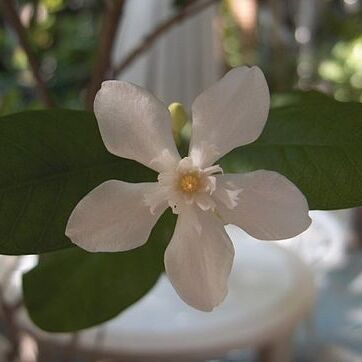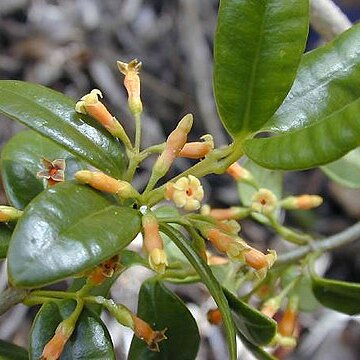Trees, shrubs, lianas, or sometimes herbs (not in our area, except introduced ones); latex nearly always present, usually white, sometimes clear, yellow or red. Leaves simple, opposite, whorled, or less often alternate (as in Adenium), pinnately veined, entire, rarely stipulate. Flowers bisexual, mostly actinomorphic, 5-or rarely 4-merous, fragrant. Calyx often with colleters inside, free or united at the base, imbricate in bud. Corolla tubular, contorted or occasionally valvate, free, overlapping to the right or left in bud, sometimes with a corona. Stamens included or exserted, epipetalous, free or connate to the style; filaments often very short, epipetalous; anthers frequently triangular, of two cells longitudinally dehiscent, often partly sterile, sometimes with apical appendages. Ovary superior or sometimes partly inferior, 1-celled and with 2 parietal placentas, 2-celled and with an axile placenta in each cell or composed of 2, or more, separate or at the base partly united carpels each with an adaxial placenta; ovules 2 to many; style one, often split at the base when carpels more or less separate; pistil head composed of a large variously shaped stigmatic basal part and a stigmoid apex; disk annular, cupular, composed of separate glands, or absent. Fruit entire or consisting of two (rarely more) separate or partly united carpels, baccate, drupaceous, or follicular. Seeds in dry fruits often winged or with a coma, mostly with an endosperm and a large embryo
Trees, shrubs, or vines, rarely subshrubs or herbs, with latex or rarely watery juice. Leaves simple, opposite, rarely whorled or alternate, pinnately veined; stipules absent or rarely present. Inflorescences cymose, terminal or axillary, with bracteoles. Flowers bisexual, 5-[or 4]-merous, actinomorphic. Calyx 5-or rarely 4-partite, quincuncial, basal glands usually present. Corolla 5-or rarely 4-lobed, salverform, funnelform, urceolate, or rarely rotate, lobes overlapping to right or left, rarely valvate. Stamens 5 or rarely 4; filaments short; anthers mostly sagittate, free or connivent into a cone adherent to pistil head, dehiscing longitudinally, base rounded, cordate, sagittate, or prolonged into an empty spur; pollen granular; disc ringlike or cup-shaped, 2-5-lobed, or absent. Ovaries superior, rarely half-inferior, connate or distinct, 1-or 2-locular; ovules (1 or) 2-numerous per locule. Style 1; pistil head capitate, conical, or lampshade-shaped, base stigmatic, apex 2-cleft and not stigmatic. Fruit a berry, drupe, capsule, or follicle. Seeds with or without coma; endosperm thick and often horny, scanty, sometimes absent; embryo straight or nearly so, cotyledons often large, radicle terete.
Ovary superior or sometimes partly inferior, 1-celled and with 2 parietal placentas, 2-celled and with an axile placenta in each cell, or composed of 2, rarely more, separate or at the base partly united carpels each with an adaxial placenta; ovules 2 to many; style one, often split at the base when carpels more or less separate; stigma composed of a large variously shaped part, usually called the clavuncula, with laterally and/or basally the receptive zone, which is — if stigma coherent with the anthers — below the level of coherence, and a small apical usually sterile (also in FZ) so-called stigma
Stamens inserted on the corolla; filaments free from each other or exceptionally (not in FZ area) united in a tube, often very short, frequently continued downwards as ridges at the corolla inside; anthers frequently triangular, connivent over and often coherent with the stigma, 2-celled, often partly sterile, sometimes with apical appendages; cells parallel, discrete, dehiscent throughout by a longitudinal slit
Stamens 5 or rarely 4, inserted in the tube; filaments free or rarely united; anthers often sagittate, free or connivent around the stigma, rarely adherent to the latter, 2-celled, opening lengthwise, connective often produced at the apex; pollen granular; disk usually present, annular, cupular or of separate glands
Ovary superior, 1-celled with 2 parietal placentas or 2-celled with the placentas adnate to the septa, or carpels 2 and free or connate only at the base with ventral placentas in each carpel
Fruit entire or consisting of two, rarely more, separate or partly united carpels, baccate, drupaceous, or follicular
Style 1, split at the base or entire, thickened and stigmatose below the apex; ovules 2 or more in each carpel
Seeds mostly with endosperm and large straight embryo, often winged or appendaged with long silky hairs
Corolla tubular, sometimes with a corona; lobes contorted or occasionally (not in FZ area) valvate
Leaves opposite or verticillate, rarely alternate, simple, entire; stipules usually absent
Seeds in dry fruits often winged or with a coma, mostly with endosperm and a large embryo
Fruit entire and indehiscent or of 2 separate carpels, baccate, drupaceous or follicular
Leaves opposite, whorled, or less often alternate, simple, pinnately veined, entire
Corolla tubular, variously shaped; lobes contorted-imbricate, very rarely valvate
Trees, shrubs, lianas, or sometimes herbs, mostly with white sticky latex
Trees, shrubs or climbers, rarely perennial herbs, with latex
Disk annular, cupular, composed of separate glands, or absent
Flowers bisexual, mostly actinomorphic, 5-or rarely 4-merous
Calyx often glandular inside; lobes 5 or rarely 4, imbricate
Flowers hermaphrodite, actinomorphic
Calyx often with colleters inside
Stipules usually absent
Pollen granular


